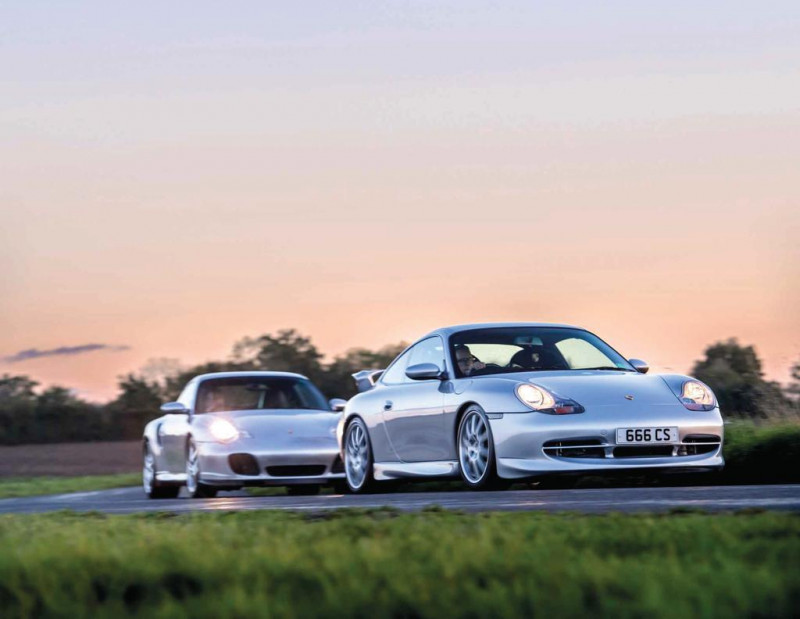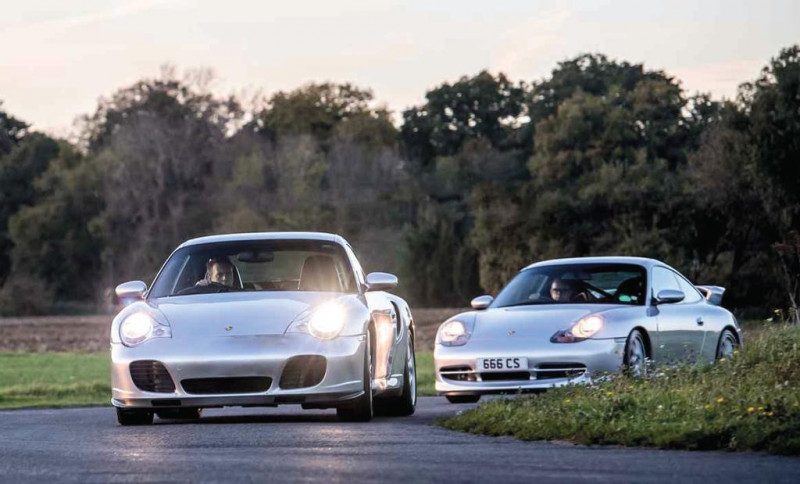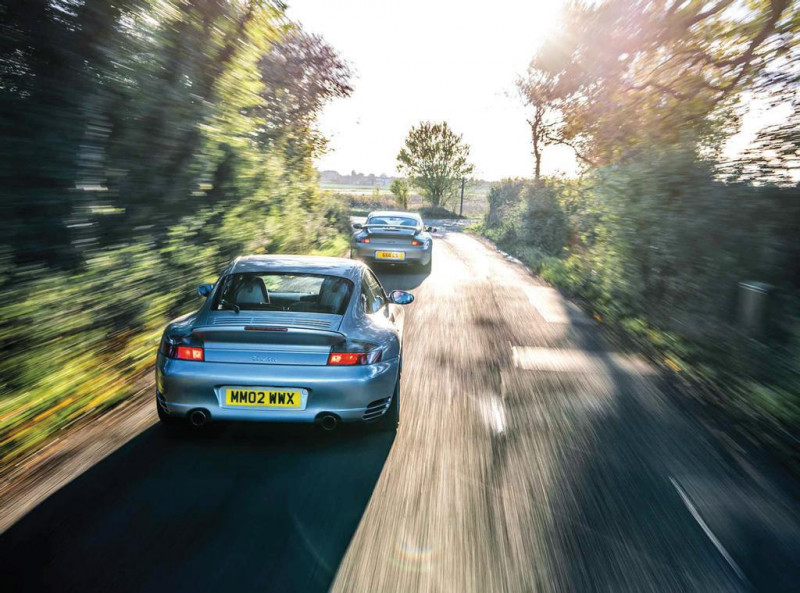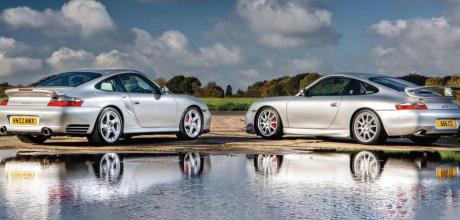2000 Porsche 911 Carrera GT3 996.1 vs. 2002 911 Turbo X50 pack 996.2
When water-cooling heralded the 996, Porsche offered the super-focused GT3 and the multi-talented Turbo. Nearly 25 years on, Octane rediscovers an icon and a bargain.
PORSCHE 911 TURBO 996.2 AND GT3 996.1 THE PURE AND THE DAMN’ BRILLIANT
Under-the-radar 996s are all-time greats — and bargains too.
Proof the 996 generation is an all-time great
Engines cooled by water, funny headlights, bits shared with Boxsters… it’s easy to underestimate how alien the 996-generation Porsche 911s must’ve seemed to air-cooled diehards when the Carrera debuted in 1997. But this bold new breed of 911 is now getting sucked into the classic world’s gravitational pull, with enthusiasts becoming misty-eyed about the days before PDK transmissions and flappy paddles, when cable throttles, narrow bodies, even those ‘fried-egg’ headlights ruled.

For all the criticisms levelled at the 996 both then and now – something reflected in 996 values compared with other generations, on which more in a mo’ – there’s no question that the 996 is an exceptionally significant 911, one that helped Porsche recover from its nadir in 1989.
Just how significant? Well, in 1989 Porsche produced only 15,000 units total, way below the usual 40,000 or so of the years before, enough to push the company to the brink of collapse. Yet from 1997 to 2005, Stuttgart made 175,262 units of the 996 alone, supported by a further 164,874 first-generation Boxsters 986 from 1996 to 2004 – a model in essence the same up to the B-pillar but differentiated by its midengined layout and much more affordable pricing. More sales, better economies of scale, mission accomplished.

Late last year, Porsche itself issued a press release acknowledging that ‘together with the Boxster, [the 996] secured the continued independence of Porsche exactly 25 years ago… With the exception of the iconic 911 design and the rear-engined drive concept, everything was new.’
‘THERE’S A SINGLEMINDEDNESS HERE THAT MAKES IT SO EASY TO “GET” THE GT3’
All 996s are sports cars, of course, but today we’ve brought together two sought-after variants that demonstrate the staggering elasticity of that proposition – race-bred GT3 of singular focus meets high-tech Turbo of many talents. Together they prove that, as much as 996 models were crucial for the Porsche business case, these two halos were and continue to be fabulous cars to drive.

If the GT3 introduced a new 911 nameplate when it debuted at the 1999 Geneva show, the concept was familiar from air-cooled RS models – motorsport was the driving force, in this case new N-GT racing rules mandating 1200 units be produced for the road. Unlike the Turbo, however, which was in the product plan from the beginning, the GT3 was more a reaction to changing motorsport regulations.
‘The [previous generation] 993 still had RS models, then the motorsport regulations were changed to GT1, GT2 and GT3. We just made a GT3 offshoot for the GT3 class for homologation. And actually it shouldn’t have been there at all,’ recalls August Achleitner, who was responsible for Technical Product Development from 1989 to 2000, before running the 911 programme from 2001 to 2018. ‘At that time, of course, we weren’t able to see that the GT3 would establish its own brand. The economic success of the GT3 wasn’t that great at first. And neither were the sales figures.’
Our 996 GT3 feature car is the first of two variants, as produced from 1999 to 2000 and known in Porsche circles as the 996.1 GT3 (the later 996.2 GT3 features Turbo-style headlights and extra power). This is only half the story, however, because Porsche produced two batches of 996.1 GT3 – 1350 ‘A’ cars for homologation, followed by 536 ‘B’ cars with a few more creature comforts. Steve Abbs’ car is in A specification, but also gets the Clubsport option with Nomex bucket seats, half roll-cage and a fire extinguisher, making it a 996.1 GT3 distilled to its purest, rawest form.
Only 28 were produced for the UK, so it’s vanishingly rare. And forget those old jibes about a bar-of-soap body, the 996 GT3 looks sensationally pure and compact today. I’ve even come to love the purity of its original fried-egg headlights (letters to the editor, please), which were designed to package five functions in one relatively affordable and quick-to-install unit.
Finished in Arctic Silver, Steve’s car is differentiated from my own Arctic Silver 996.1 Carrera (brought along as a sense-check) by the Aerokit and split-rim 18-inch alloys that were optional on the Carrera anyway. It all adds a little extra visual punch to a design overseen by design boss Harm Lagaaij and worked up entirely in 1:1 scale by a team of up to 80 as Porsche fast-tracked the 996 to market.
Perhaps visually more significant than the wheels and wings, however, is a ride height dropped some 30mm. First impressions suggest the stance is too low to be standard, even if it’s just as Weissach intended, revised geometry and all. What you can’t notice without lifting the bonnet and revealing a smaller luggage area is that GT3s use the reinforced Carrera 4 bodyshell – explaining why weight actually rose by around to 1350kg versus the Carrera’s 1320kg, though larger wheels and brakes contribute.
The cabin is austere: rear seats are replaced with a carpeted expanse as is GT3 tradition, the dash and doorcards of Clubsports are bare plastic rather than covered in stitched leather, the absence of side airbags allows owners to upgrade to a full roll-cage (the holes are pre-drilled from the factory but the threads are still waxed in Steve’s car), and even the wing mirrors are manually adjusted, though no-cost optional stereo and air-con are fitted here.
Continuing with air-cooled engines for any 996 wasn’t an option. ‘The air-cooled engines were still two-valve, which were exhausted in terms of emissions and performance,’ explains Achleitner. ‘There were attempts with air-cooled four-valve engines, but these failed due to unmanageable temperature nests in the cylinder-head area.’
In 1989 Porsche even fitted a compact V8 engine to a test mule before settling on a four-valve, six-cylinder water-cooled boxer engine. ‘The biggest challenge was actually not the engine itself, but the integration of the water-cooling system in the vehicle, specifically the radiator concept in the front end,’ recalls Achleitner.
However, rather than being related to the Carrera’s 3.4-litre flat-six, the GT3’s 3.6-litre is instead derived from the Mezger unit in the Le Mans-winning GT1 (as is the Turbo’s) and is widely regarded as the far tougher engine. Titanium con-rods and an uprated crankshaft help withstand the GT3’s higher maximum engine speed of 7800rpm, and its 355bhp and 273lb ft are 60bhp and 15lb ft up on the Carrera – good for 0-60mph in 4.8 seconds and 188mph flat-out. The tougher 993 GT2-derived gearbox differs from a Carrera’s, too.
Even if it’s the more durable powertrain, the racket from the Clubsport’s single-mass flywheel suggests catastrophic failure. It pulses and churns grumpily at idle, but resonates through those snugly supportive bucket seats to hardwire you to the GT3’s mechanical grit. Lift the firm clutch, tap at the throttle to manage revs that flick up and fall like a kid on a trampoline and we’re off, nestled down low, legs dead ahead, vision excellent out over the front wings and astern over the boomerang rear spoiler.
While the GT3 thrives on speed and revs, happily it’ll engage its driver at a gentler velocity. It surges forwards from 1500rpm with only a modest squeeze on the cable-operated throttle, the steering is gorgeously detailed with fluid weighting and a rhythmic cadence as the road surface ebbs and flows, and everything from the brake pedal to the bodyshell feels taut and direct. Pedals perfectly aligned for heel-and-toe and a gearshift that needs a positive slot home underline this physical, immersive experience.
‘THE STEERING IS GORGEOUSLY DETAILED, WITH A RHYTHMIC CADENCE AS THE SURFACE EBBS AND FLOWS’
With fluids warm, the Mezger engine pulls strongly and smoothly through the range, its exhaust note warming to a more cultured tone before pulling past 7000rpm with the howling flat-six blare. It’s deliciously crisp and thrilling at high revs and plenty quick enough, even if it lacks the incandescent fury of later 996 GT3 models, which combine more generous performance with a more pronounced on-cam kick in the upper reaches of the rev range.
The linearity and response of the engine also beautifully complement this precision chassis. Don’t take the slow-in/fast-out cornering cliché of 911 lore too literally, just know that the GT3’s bottom-heavy weight distribution prefers carrying generous speed into the corner off-throttle or with some measured braking rather than accelerating early – either method helps the light front end bite positively, so it goes directly where you aimed it, with precious little body roll or flex diluting feedback or accuracy.
With the front end locked onto the apex and its body settled, the weight of the engine progressively comes into play, smearing the rear tyres just a little over the surface – you feel the steering lock wind off slightly in your hands, pointing the GT3 straighter so it’s ready to be guided on the throttle. At this point you can either dig into the traction inherent in six cylinders pressing 285-section rear tyres into the surface or squirt it a little out of line for fun, letting those eager revs flick up and fizz.
If anything, the rear feels even tighter than the front – a combination of stiff suspension, limited-slip diff, half-cage bracing the structure, that lump of engine squishing into the surface, and the dexterity of the ‘LSA’ (Lightweight, Stable, Agile) rear axle. Like the Turbo’s, this multi-link set-up is an evolution of a design that made its debut in the previous 993 (and quite possibly wouldn’t have been developed at all had Porsche not been planning a four-door limousine). It’s transformative to a 911’s handling, and Achleitner actually describes the previous semi-trailing arm set-up as ‘completely unsuitable for a rear-engined vehicle’. Some will no doubt disagree strongly with that, but it’s a big part of why the GT3 is both tantalisingly malleable and securely planted.
The downside of the GT3 chassis more widely is suspension that – while often perfectly tolerable – can become too reactive over a bumpier B-road like this, and a ride height that can run out of answers whether you’re tiptoeing up a driveway or bracing for a larger compression at speed. ABS is the only safety net (and very welcome it is, too), but it can intervene excessively when the suspension starts skipping, reducing the strong stopping power. Nonetheless, there’s a single-mindedness here that makes it so easy to ‘get’ the GT3.
The Turbo is the more complex proposition, not only in terms of engineering ambition but also because it was produced for a more mainstream audience, not a governing body – performance, luxury, refinement, all-weather security, manual or Tiptronic auto, coupé or convertible, it all informed this product plan.
Porsche shifted more than 16,000 coupés alone, building on a template laid down since the 1970s, yes, but really refining the giant leap made by the 959 supercar and subsequent 993-era 911 Turbo – notably all-wheel drive (the lightest on the market when Porsche launched the system on the 993) and a twin-turbocharged flat-six engine.
Where the 996 GT3 looks meek to some, the Turbo’s body is engorged like pumped biceps. Bulging haunches widen the body by 6.6cm to house 295-section rear tyres, large air intakes in the front bumper feed radiators 50% larger than a Carrera’s, extra intakes take a swipe out of the rear ’arches, even the rear bumper is slashed with outlets.
Like the GT3, there are two key versions of 996 Turbo, though both use a 3.6-litre Mezger engine and there’s all-wheel drive that can shift up to 40% of shove forwards using a passive Visco clutch, just like the 993 – the evolution here being that the clutch runs in an oil bath for better cooling.
Matt Woods’ Turbo comes from the initial 2000-on production run. These cars make 414bhp at 6000rpm, but Matt’s is equipped with the official ‘X50’ power upgrade that takes the first cars to 444bhp at 5700rpm. That brings performance parity with the 2004-on Turbo S models – and with the 959. Zero to 60mph is done in 4.1 seconds, the top speed stretched to 191mph, making this a big leap over its 993 predecessor’s 184mph and the first Porsche production car to break the 300km/h barrier (188mph).
Inside you might spot the central tacho redlined at 6600rpm – down 1200rpm on a GT3 – but more obviously there’s leather for the dashboard, doorcards and steering wheel boss, even actual rear seats – and, while you can’t see the sound deadening, there’s a dull thud when you tap the top of the roof, not the tinny resonance of a GT3. No wonder that, lavished with extra kit, the 996 Turbo became 40kg heavier than its predecessor, undoing the 50kg saving Porsche managed for the Carrera.
Considering its brief to be a more rounded tool for a wider audience, it’s perhaps surprising that the Turbo takes longer to reveal its talents than the GT3. The clutch is heavy but bites rather indistinctly, twin KKK turbochargers damp the soundtrack to a more muted, less vital thrum than that of the related unit in the GT3, and the near-200kg weight penalty is immediately obvious, partly because the Turbo rides quite lumpily, suspension working hard to keep its body in check.
Extra mass narrows the power-to-weight advantage to just 25bhp-per-tonne over a GT3, and there’s also a less incisive feel from the steering as you carve it into corners, though it’s hardly lethargic. Drive gently and you might wonder what all the fuss is about, and if you might be better served by a Carrera. Dig into the performance, though, and the Turbo finds its focus. Squeeze the (electronically controlled) throttle and there’s a swell of torque low down, and surprisingly prompt throttle response for a two-decade-old blown engine, not the mush typical of the era.
Like a firework still stuck in the ground that’s too dangerous to return to, nothing’s quite happened yet, but you feel the suspense of building boost until you hit 3400rpm or so and the Turbo ignites with a kick, sitting back on its haunches and chewing at its 295-section tyres like a dog shaking a bell-bottom trouser – it is very much rear-biased with extra support from the front. The final 1500rpm or so is a riot of boosty violence released in a spit of exhalation, in stark contrast to the linearity of the GT3.
‘THE TURBO IS A RIOT OF BOOSTY VIOLENCE RELEASED IN A SPIT OF EXHALATION, IN CONTRAST TO THE LINEARITY OF THE GT3’
Matt’s added a short-shift kit to his Turbo, and it’s perhaps too short – I want the reassuring engagement of a longer throw, particularly when you’re punching ratios so rapidly. This shift is indeed quick though a little vacant.
Compressions that have the GT3 bottoming out are simply shrugged off by the Turbo’s damping and greater ride height but both 996s are brilliant under braking (when the GT3’s ABS doesn’t trigger) – firm pedal, big stopping power and rear-biased weight distribution that greatly reduces nose-dive. While corners aren’t dispatched with the absolute precision or intimate feel of the GT3, and the wallop of boost and all-wheel drive make the Turbo’s dynamic intentions harder to read, it is more malleable and analogue than two driven axles perhaps suggest.
It also obeys the same basic physics, so, if you arc it into a turn quickly off-throttle, the wide-hipped rear will still smear round, though it’ll shoot off down the road more dramatically when you push into the throttle, power shifting forwards and clawing grip from the surface.
Better still, the Turbo allows you to explore much of its on-limit behaviour with stability control engaged, rather than throttling progress the second it senses slip. I certainly know which 911 I’d rather pedal quickly over an unfamiliar road in less-than-perfect conditions.
The extra usability, performance and equipment saw the Turbo priced at £86,000 in the early 2000s, around £10,000 more than a GT3, but as these two 996s have matured to become classics, so the focus has shifted to collectability, production numbers and weekend driving enjoyment, and the tables have turned – today a 996 GT3 typically stretches from the mid-£70,000s to £90,000, with Clubsports commanding a significant premium on that.
This makes the Turbo something of a steal, with prices starting in the mid-£30,000s and few breaching £60,000, though mileages are typically higher. It’s the 996 to use and enjoy without being too precious about future values and today’s weather, whereas the GT3 is the driver’s choice with its keener, purer responses. Just as it always was.
As such, both models are typically more affordable than their predecessors and their immediate successors, in some ways reinforcing the 996’s position as the unloved transition between air-cooled past and water-cooled present. But after driving these two very different twists on the 996 theme, I find myself reaching an alternative conclusion: that they unite the best of both.
TECHNICAL DATA 2000 Porsche 911 Carrera GT3 996.1
- Engine 3600cc 24v flat-six, DOHC per bank, electronic fuel injection and engine management
- Max Power 355bhp @ 7200rpm
- Max Torque 273lb ft @ 5000rpm
- Transmission Six-speed manual, rear-wheel drive
- Steering Power-assisted rack-and-pinion
- Suspension Front: MacPherson struts, coil springs, anti-roll bar. Rear: multi-link, coil springs, telescopic dampers, anti-roll bar Brakes Discs
- Weight 1350kg
- Top speed 188mph
- 0-60mph 4.7sec
TECHNICAL DATA 2002 Porsche 911 Turbo (X50 pack) 996.2
- Engine 3600cc 24v flat-six, DOHC per bank, electronic fuel injection and engine management, twin-turbocharged, inter-cooled
- Max Power 444bhp @ 5700rpm
- Max Torque 457lb ft @ 3500-4400rpm
- Transmission Six-speed manual, four-wheel drive
- Steering Power-assisted rack-and-pinion
- Suspension Front: MacPherson struts, coil springs, anti-roll bar. Rear: multi-link, coil springs, telescopic dampers, anti-roll bar Brakes Discs
- Weight 1540kg
- Top speed 191mph
- 0-60mph 4.1sec
THANKS TO PIE Performance (pieperformance.co.uk), Suffolk Sports and Supercar Club (suffolksportsandsupercarclub.com), Car-Iconics (car-iconics.com).


